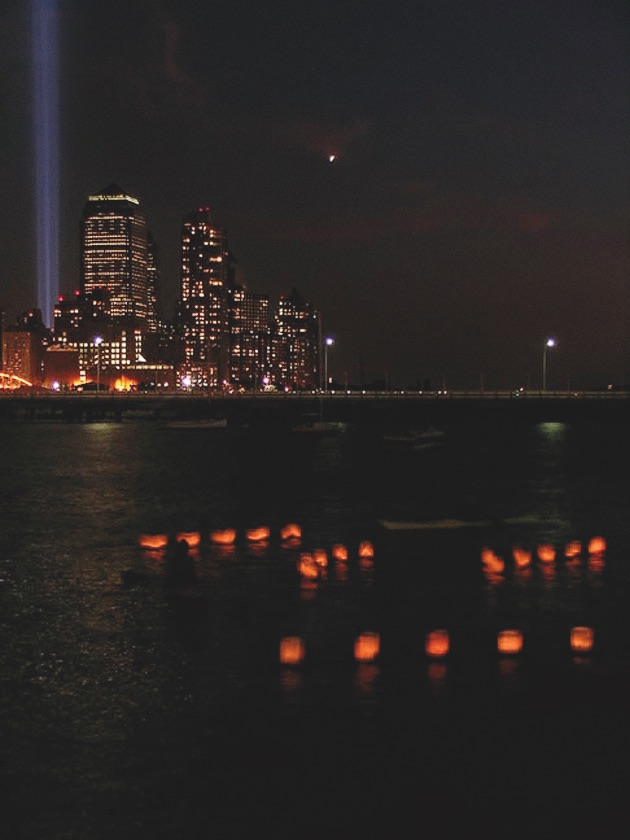Nature will not have us fret and fume. She
does not like our benevelonce or our learning
much better than she likes our frauds and wars.
-Ralph Waldo Emerson, “Spiritual Laws”
Like every New Yorker who was living in the city on that cloudless day five years ago, I had been to other local memorials; in the fall of 2001, the visceral debris of aftermath made potent shrines. Standing in sick awe before the white-dust-coated hole at Ground Zero, or reading names on the heartbreaking “MISSING” posters, I remember feeling the relief of real contact, of collective concentration in the face of shock. In the intervening years, I’ve felt a sense of comfort when the twin beacons—the “Tribute in Light”—shine from the horizon on the anniversary. Otherwise, I’ve avoided commemorations. For me, “We will never forget!” has begun to sound hot, fuming, ominous.
This September eleventh, I went to the Memorial Floating Lanterns Ceremony sponsored by the New York Buddhist Church. This annual gathering takes place at Pier 40 on the Hud- son River, just north of the World Trade Center site, beginning at 6 p.m. with volunteers at tables inviting passersby to write a message on the panels of white paper that would make the lanterns. I saw “Tokyo Fire Department,” “Tony’s sister rest forever,” and Xeroxed thumbnail photographs of firefighters. Pax, paz, peace. Music played, and participants assembled as the twilight deepened. Sailboats rocked at anchor, while gold rays beamed from a cloud above Hoboken. Joggers and rollerbladers paused, and soon there were about two hundred people leaning on the railings, talking quietly, looking out toward the Statue of Liberty. Kids ran around. Volunteers from the New York Kayak Company, whose office is on the pier, floated below us resting on their paddles, waiting to tow the lanterns into place. There was taiko drumming—amazing power in the drummers’ slender bodies—and the Pure Land priest Rev. T. Kenjitsu Nakagaki chanted the Juseige, the Forty-Eight Vows of the Bodhisattva Dharmakara, who pledges to save all sentient beings. An interfaith minister read Psalm 46:
Therefore will not we fear,
though the earth be removed,
and though the mountains be carried
into the midst of the sea;
though the waters thereof roar and be
troubled.
The sunset intensified until a blast of molten light lit up each face, and pink striations reflected in the bluish glass of Financial District buildings. Nothing was particularly somber. The sky turned fleetingly ecstatic, and, looking into the eyes of those around me, I saw no tears. It was like a subdued but cheerful village festival.
Then it was dark, and a bagpiper played “Amazing Grace” while a long line of volunteers carried the lanterns, tethered together, down the pier to the kayakers. Buddhist monks, a Shinto priest, the interfaith minister, and an elder from the group Women in Islam recited prayers. A strange dimple of white appeared in a cloud, and I thought briefly that it must be the moon. Moments later, it coalesced into the Tribute in Light, shooting vertically into the night while the yellow candlelit lanterns bobbed on the river below. People stood in little groups, taking cell-phone photos and holding hands.
I thought about the dynamic, abiding principle of nature that does not shake, even when its waters roar. It seems bold in Emerson—that early American reader of Buddhist texts—to discern that this true nature does not deem benevolence and learning “much better” than fraud or war; to suggest that even our most earnest allegiances can occasionally drop into just a fresh breeze off the Hudson. The lady who’d been painting the whole scene in watercolor packed up her brushes and her grandchildren, and went home.
Thank you for subscribing to Tricycle! As a nonprofit, we depend on readers like you to keep Buddhist teachings and practices widely available.
